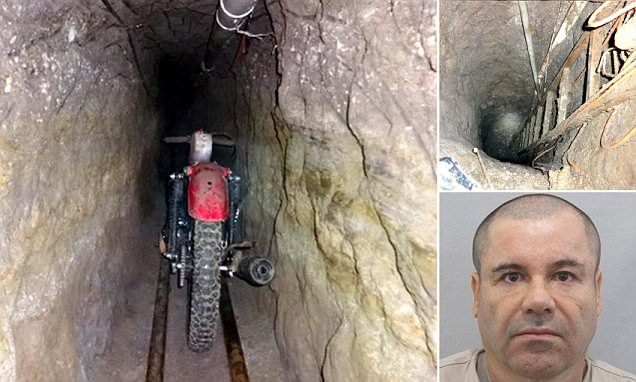Have you ever imagined being a billionaire? How about being a fugitive? Well, El Chapo was both a billionaire and a fugitive. Joaquin “El Chapo” Guzman became the leader of the Sinaloa cartel in the late 1980s. He was first captured on June 9, 1993, and was transported to Almoloya maximum security prison in Mexico. El Chapo constantly asked to be relocated, and in November of 1995, he was sent to the Puente Grande prison near Guadalajara. On January 19, 2001, El Chapo escaped by hiding in a dirty-laundry cart which guards led to the gate, and then he proceeded to walk out the building dressed as a policeman. The escape was like something you would see in a movie. Shortly after his escape, El Chapo resumed his leadership in the Sinaloa Cartel, which is one of the most powerful and violent drug trafficking syndicates in the world. The Sinaloa Cartel primarily smuggles and distributes Columbian cocaine, Mexican marijuana, methamphetamine, and Mexican and Southeast Asian heroin into the United States.1

On February 22, 2014, El Chapo, asleep next to his wife and 2-year-old twin daughters, was captured at a hotel in Mazatlan, Sinaloa. He had no time to escape nor grab his weapons. Once he was captured, the United States wanted El Chapo to be handed across the border for drug trafficking charges in U.S. federal court. However, Mexico insisted that they would detain El Chapo, and keep him so secure that he would not see the world in hundreds of years.2 He returned to prison after making a legendary escape 13 years ago through a tunnel he had fabricated. The prison he was placed in went to great lengths to ensure its security — by checking if the walls were hollowed, having a set shower time, and forcing inmates to have their heads shaved every seven to twelve days. Mexico officials felt that El Chapo should do his time in Mexico before being extradited to the United States.3

On Saturday, July 11, 2015, word spread that El Chapo had escaped Altiplano Prison again. The next morning Mexican officials confirmed this news. Surprisingly, he had escaped through a 1.5-kilometre tunnel from a small opening in the shower area of his cell.4 Altiplano has a multitude of ground-level security measures such as the prison being covered in CCTV cameras and access control points.5 El Chapo was located in the special treatments area, hallway two, cell 20. The video footage Osorio Chong released from inside El Chapo’s prison cell showed Guzman entering the shower then disappearing at 8:52 p.m.6
One inmate, Flavio Sosa, was in the same unit seven years prior at the prison from which El Chapo escaped. He claims that this prison is not one you can easily escape from, because there are only 20 inmates in the special treatment area and a camera is watching you at all times in your cell. On top of that, there is a special visit program to intimidate inmates and inspect every cell thoroughly. In his words, “They strip you naked and once you are naked you have to do three squats, show them your testicles… Then, they enter your cell with dogs to examine it, with a tool that they use to knock on the wall on the floor… You have a shower time at 5:45 in the morning. Nobody can turn on the shower during the day or night.” This escape really exposed the weaknesses in the Mexican justice and prison system.7

This isn’t the first time El Chapo has used tunnels to traffic or escape authorities. The tunnel he used to escape Altiplano prison also gave people a glimpse of the tunnels the Sinaloa Cartel likely use to traffic drugs across borders without being detected. Many people blame the Mexican government for the escape of El Chapo, causing them to lose trust in their government. El Chapo’s escape was demoralizing — through it, Mexican citizens lost the trust of the government’s abilities to protect their citizens as well as the trust between both borders. 8
- Romero L. Gomez, “El Chapo’ jailbreak is both a Mexican and an American story,” The Conversation (1-4), July 17, 2015. ↵
- E. Eduardo Castillo and Katherine Corcoran, “Cartel boss escapes Mexican prison; Joaquin ‘El Chapo’ Guzman used elaborate, 1.5-km tunnel in second break from jail,” The Toronto Star, 2015. ↵
- Rafael Castillo, “Inside El Chapo’s Escape Tunnel,” Vice News, Jul 24, 2015, video. ↵
- E. Eduardo Castillo and Katherine Corcoran, “Cartel boss escapes Mexican prison; Joaquin ‘El Chapo’ Guzman used elaborate, 1.5-km tunnel in second break from jail,” The Toronto Star, 2015. ↵
- Helen Regan, “Newly-Released Footage Shows Joaquin ‘El Chapo’ Guzman Moments Before His Escape,” Time, 2015. ↵
- Rafael Castillo, “Inside El Chapo’s Escape Tunnel,” Vice News, Jul 24, 2015, video. ↵
- Rafael Castillo, “Inside El Chapo’s Escape Tunnel,” Vice News, Jul 24, 2015, video. ↵
- Alfredo Corchado, “Mexican drug lord Joaquin ‘El Chapo’ Guzman tunnels out of prison,” Dallas Morning News, July 13, 2015. ↵



147 comments
Pedro Gonzalez Aboyte
Being able to escape from maximum security prisons seems absolutely impossible but El Chapo did it. It is truly incredible how much influence this drug lord has. These escapes cannot be merited to just Chapo and the cartel, but there also had to be people who helped on the inside. It shows the corruption and weakness of Mexican law enforcement but also the power of the cartels. There is also the question of whether he should have been handed over to the United States. There are many things that can be said about these escapes and many, if not all, reflect just how poorly the Mexican government handles these situations.
Caden Floyd
You would think any prison would know to keep more eyes on the notorious El Chapo at all times.The whole tunnel system amazes me. The time and effort the cartel has to put in to their advanced drug trafficking is unmatched. The way the security measures are described makes it seem almost impossible to escape, but somehow he managed to get out through a 1.5 kilometer tunnel. I personally believe that he had someone working with him inside this prison, but that still raises the question as to how they wouldn’t get caught as well.
Kacey Diaz
Escaping a maximum security prison not once, but twice, really does show the weaknesses in a prison, especially a maximum security prison designed to keep people in. The escape doesn’t just point out the weaknesses of Mexican Law Enforcement, but it points out the weaknesses in the Mexican government which doesn’t leave much room for the Mexican citizens to have much hope or faith in their government.
Michael Othon
It was a horrible decision from the start to let the Mexican government hold El Chapo in their prisons. They should have known better than to do this as the Mexican Government is corrupt. It was bound to happen as he has a lot of power and money to get guards to help him in his escape. Luckily he was sent to the States back in 2017 and is awaiting trial.
Sabrina Hsu
It’s no wonder the people of Mexico blamed the government for El Chapo’s escape, for him to escape once is one thing, but twice is just unbelievable. Maybe if they had handed him over to the US, he wouldn’t have escaped at all. The Mexican government really needs to do more to make sure this doesn’t happen again, especially not at what is supposed to be a maximum security prison.
Rebecca Campos
This story was unfortunate for a number of reasons. It was a relief when El Chapo had been finally apprehended but then the escape caused even more uproar because the people of Mexico had felt like their government was negligent. While the means of his escape may have been very hard to predict, the repercussions of the escape seem to be even worse than the escape itself. The author definitely told a controversial and relevant story that discusses one of today’s more prominent current events.
Noah Bolhuis
It is obvious that El Chapo has a lot of power in his cartel. Being able to escape a maximum security prison any country seems impossible, but he was able to manage it through his rankings in the violent cartel. This also shows the weakness of Mexican Law Enforcement. If someone is able to escape a maximum security prison multiple times in the span of a few years, it shows a lot about the problems they have. It is sad that they wouldn’t hand him over to the US, as he and his cartel have brought tons of drugs into the country and committed many crimes.
Alexandra Rodriguez
El Chapo’s persistent and consistent efficiency in escaping more than one prison raises the question of, who helped him? It would be so hard to manage an entire escape from the outside only, there had to be inside help. However those helping him, where they forced by threats or willingly doing so? Considering Chapo’s criminal reputation, it would be safe to assume that those who assisted were very likely to have been threatened to do so.
Dylan Sanchez
This shows just how incompetent the federal government of Mexico is. I can only imagine being in the shoes of the citizens of Mexico. El Chapo truly does have true authority over everyone. How powerful a man must be to be in a maximum security prison and escape with such ease.
Amanda Hernandez Joya
So interesting, it makes me think that they’re had to have been other people envolved. The fact that it was that difficult to escape and the checks of that prison there’s no way he would be able to do that all on his own, and the fact that he escaped multiple times. There had to have been someone of high power in that jail helping him through his escape.